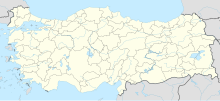Bridge at Oinoanda
Coordinates: 36 ° 49 ′ 31.1 ″ N , 29 ° 33 ′ 43.4 ″ E
The Bridge at Oinoanda or bridge of Kemerarası is an Ottoman arch bridge over the river Xanthos (today's Eşen Çayı ) near the ancient city Oinoanda in Lycia ( Turkey ). It is located on or near the site of a previous Roman building , the existence of which became known in the 1990s when an ancient bridge inscription was found.
Roman bridge
Inscription stone
The Roman inscription stone was discovered in the ancient excavation field near Kemerarası at the foot of the city hill of Oinoanda (Urluca). The site already served as a traffic junction for the upper Xanthostal in ancient times. The Ottoman bridge is also located here parallel to the modern car bridge. The limestone block found face up and largely intact is 130 cm high, 64 cm wide and approx. 42 cm thick. On the right side of the inscription, a large piece of stone has been chipped off, which requires additional text. Further difficulties of interpretation arise from a number of orthographical errors, the peculiarity of which suggests that the stonemason was probably a native Greek speaker.
Chronological order
The inscription and with it the construction of the Roman bridge can be dated to the reign of the Lycian governor Eprius Marcellus , who was demonstrably in office when the emperor Claudius died in 54 AD. After comparing the text with the known chronology, Milner narrowed the construction date to the year 50 AD and saw a connection with Roman road construction activities that began with the annexation of Lycia seven years earlier and were carried out by Marcellus' predecessor Quintus Vernanius . Since, in addition to the construction of a military road network , which was intended to move troops quickly, the demolition of Lycian city and fortress walls is also documented for this time, the Roman bridge of Oinoanda can possibly be seen as part of a broad-based Roman pacification campaign in the province .
Inscription text
Transcription (with additions):
- TI CLAVDIVS DRVSI F
- CAESAR DEVS AVG GER
- MANICVS PONTIFE [x]
- MAX TR [I] BVNICIAE P [ot]
- X COS V IMP X II DES [ig]
- PP PONTEM PER T [CL?]
- EPRIVM MARCELLVM
- [L] EG AVG PROPR SO A
(Corrected and supplemented) translation:
- “Ti (berius) Claudius Caesar, son of Drusus, God, Augustus, Germanicus, Pontifex Maximus, with tribunician power for the 10th time, consul for the 5th time, with imperial acclamation for the 12th (18th) time, des [ig (nier)] Ko (n) s (ul), father of the fatherland, (built) the bridge through T (itus) [Cl (odius)?] Eprius Marcellus, praetorical legate of (Aug) ustus, so (dalis) A (ugustalis). "
See also
literature
- Nicholas P. Milner: A Roman Bridge at Oinoanda. In: Anatolian Studies . 48, 1998, pp. 117-123.
Web links
- Map of the ancient road layout near Oianda
- Photo on Panoramio
